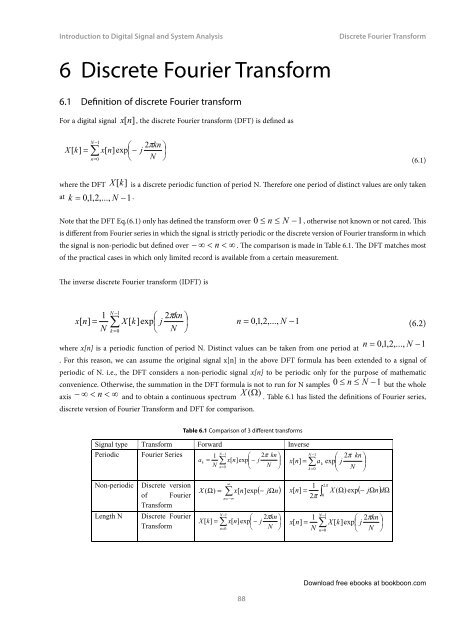Introduction to Digital Signal and System Analysis - Tutorsindia
Introduction to Digital Signal and System Analysis - Tutorsindia
Introduction to Digital Signal and System Analysis - Tutorsindia
You also want an ePaper? Increase the reach of your titles
YUMPU automatically turns print PDFs into web optimized ePapers that Google loves.
<strong>Introduction</strong> <strong>to</strong> <strong>Digital</strong> <strong>Signal</strong> <strong>and</strong> <strong>System</strong> <strong>Analysis</strong><br />
Discrete Fourier Transform<br />
6 Discrete Fourier Transform<br />
6.1 Definition of discrete Fourier transform<br />
For a digital signal x [n]<br />
, the discrete Fourier transform (DFT) is defined as<br />
N<br />
<br />
= − 1<br />
2πkn<br />
X [ k]<br />
x[<br />
n]exp<br />
− j <br />
n= 0 N (6.1)<br />
where the DFT X [k]<br />
is a discrete periodic function of period N. Therefore one period of distinct values are only taken<br />
at k = 0,1,2,...,<br />
N −1<br />
.<br />
Note that the DFT Eq.(6.1) only has defined the transform over 0 ≤ n ≤ N −1<br />
, otherwise not known or not cared. This<br />
is different from Fourier series in which the signal is strictly periodic or the discrete version of Fourier transform in which<br />
the signal is non-periodic but defined over − ∞ < n < ∞ . The comparison is made in Table 6.1. The DFT matches most<br />
of the practical cases in which only limited record is available from a certain measurement.<br />
The inverse discrete Fourier transform (IDFT) is<br />
N<br />
<br />
= − 1<br />
1<br />
2πkn<br />
x[<br />
n]<br />
X [ k]exp<br />
j <br />
N k = 0 N <br />
n = 0,1,2,...,<br />
N −1<br />
(6.2)<br />
where x[n] is a periodic function of period N. Distinct values can be taken from one period at<br />
n = 0,1,2,...,<br />
N −1<br />
. For this reason, we can assume the original signal x[n] in the above DFT formula has been extended <strong>to</strong> a signal of<br />
periodic of N. i.e., the DFT considers a non-periodic signal x[n] <strong>to</strong> be periodic only for the purpose of mathematic<br />
convenience. Otherwise, the summation in the DFT formula is not <strong>to</strong> run for N samples 0 ≤ n ≤ N −1<br />
but the whole<br />
axis − ∞ < n < ∞ <strong>and</strong> <strong>to</strong> obtain a continuous spectrum<br />
X (W)<br />
. Table 6.1 has listed the definitions of Fourier series,<br />
discrete version of Fourier Transform <strong>and</strong> DFT for comparison.<br />
Table 6.1 Comparison of 3 different transforms<br />
<strong>Signal</strong> type Transform Forward Inverse<br />
Periodic Fourier Series<br />
− 1<br />
1 N 2π<br />
kn <br />
ak<br />
= x[<br />
n]exp<br />
− j<br />
x[<br />
n]<br />
=<br />
N n=<br />
0 N <br />
N<br />
− 1<br />
ak<br />
k = 0<br />
2π<br />
kn <br />
exp<br />
j<br />
<br />
N <br />
Non-periodic<br />
Length N<br />
Discrete version<br />
of Fourier<br />
Transform<br />
Discrete Fourier<br />
Transform<br />
X<br />
2π<br />
( Ω)<br />
= x[<br />
n]<br />
exp( − jΩn)<br />
x[<br />
n]<br />
= X ( Ω) exp( − jΩn) dΩ<br />
∞<br />
n=<br />
−∞<br />
N<br />
<br />
= − 1<br />
2πkn<br />
X[<br />
k]<br />
x[<br />
n]exp<br />
− j <br />
n= 0 N <br />
x[<br />
n]<br />
1<br />
2π<br />
0<br />
N<br />
<br />
= − 1<br />
1<br />
2πkn<br />
X [ k]exp<br />
j <br />
N n= 0 N <br />
88<br />
Download free ebooks at bookboon.com
















